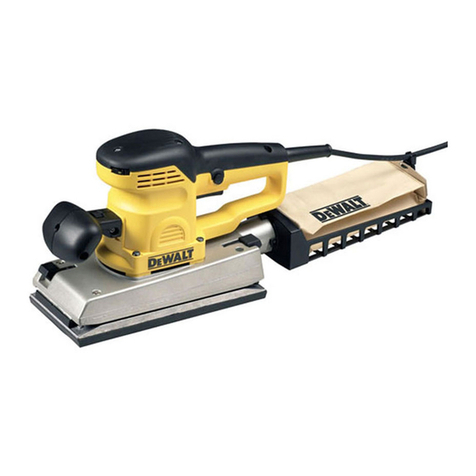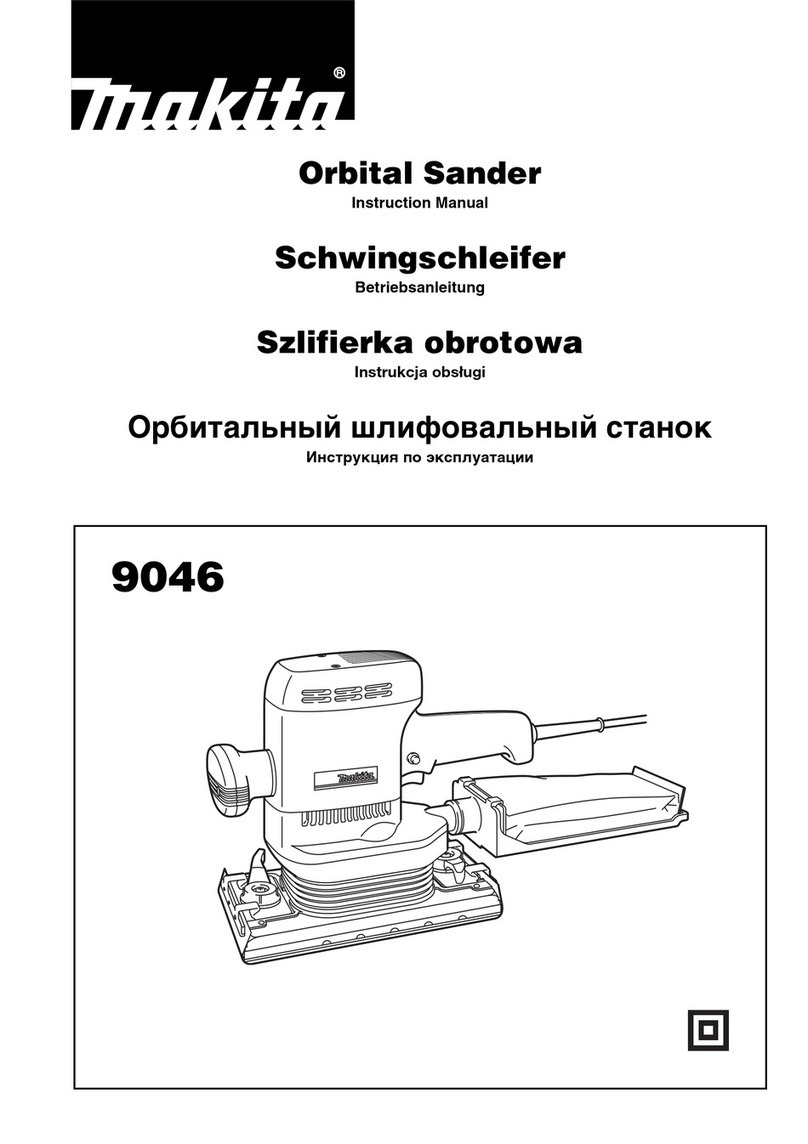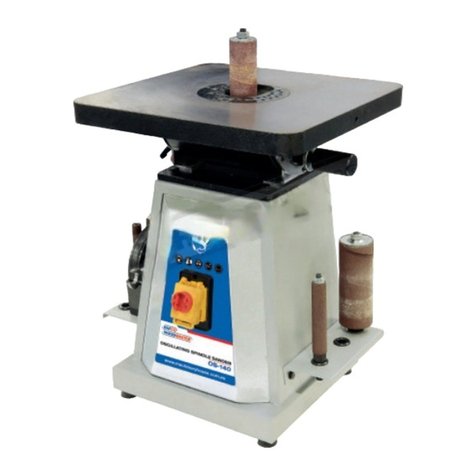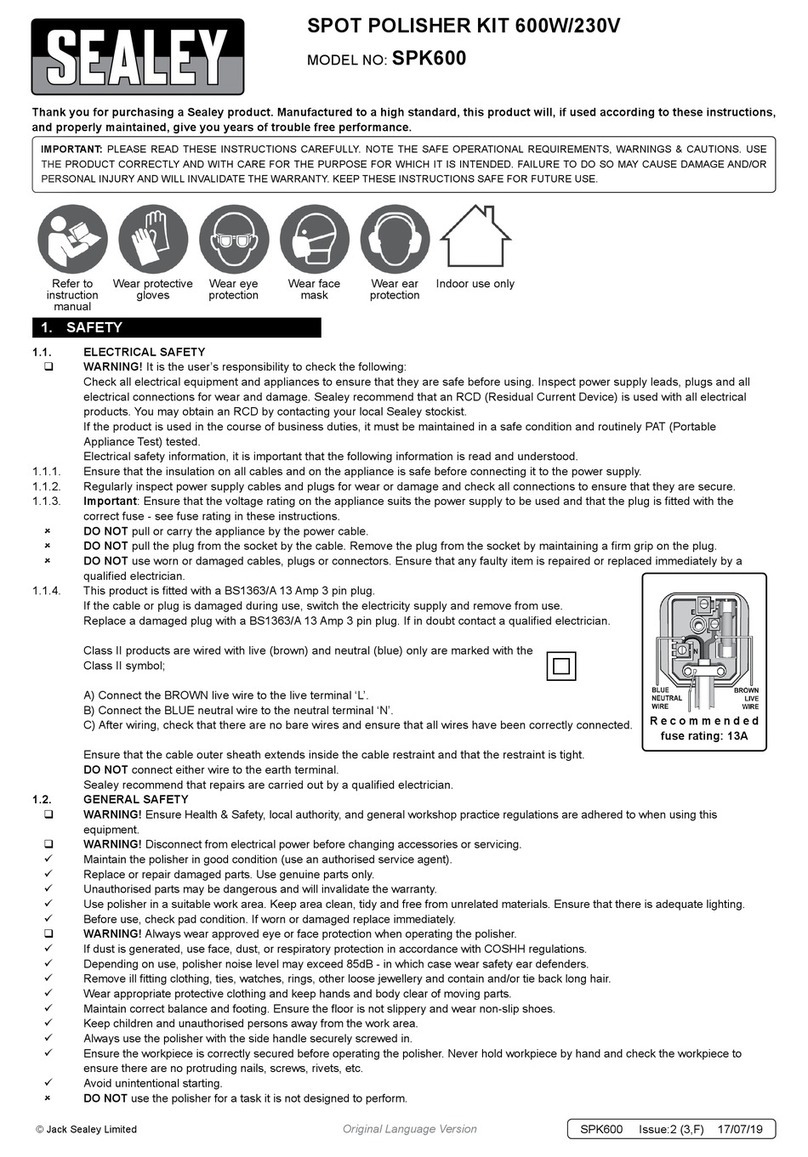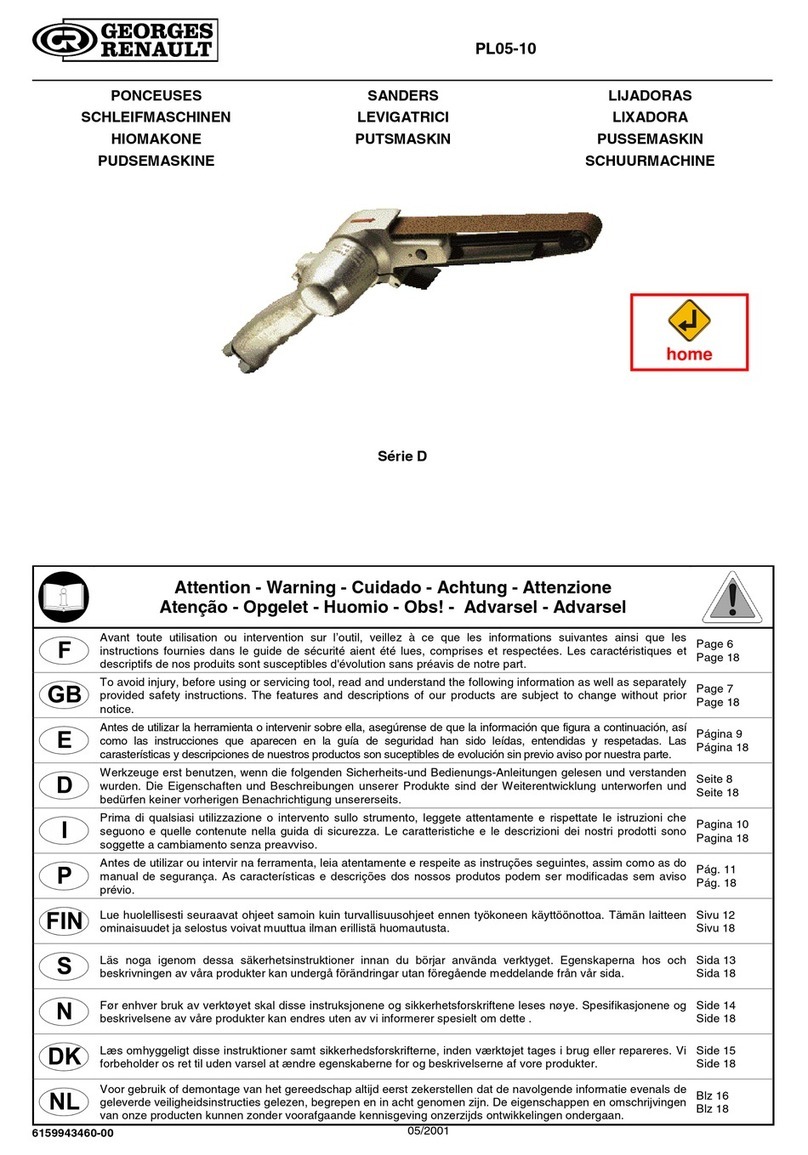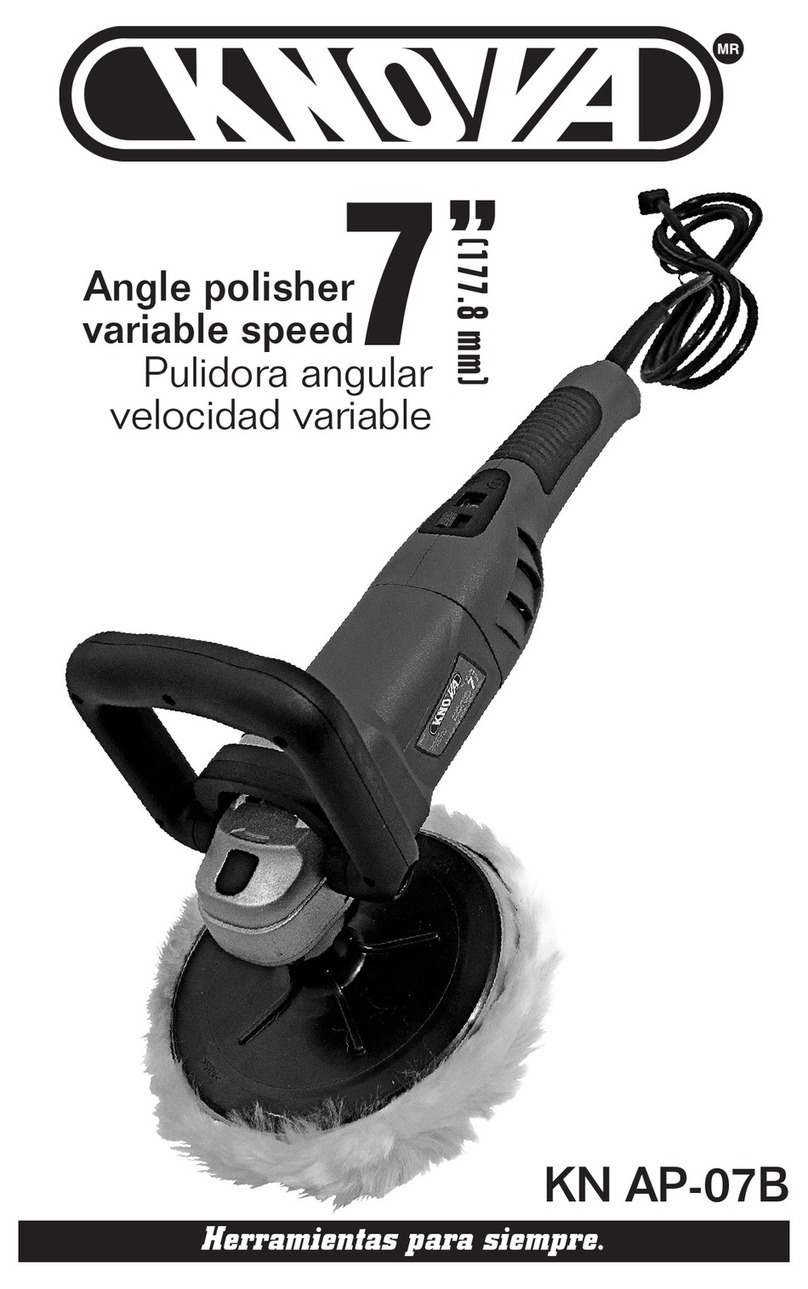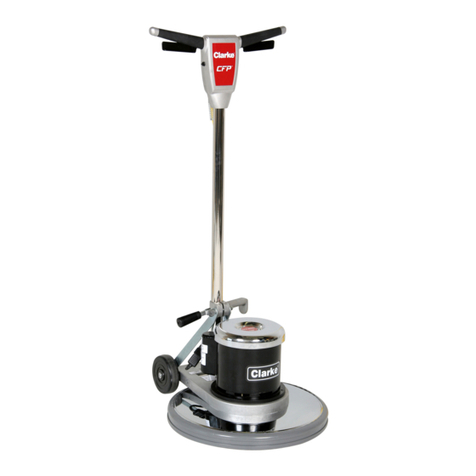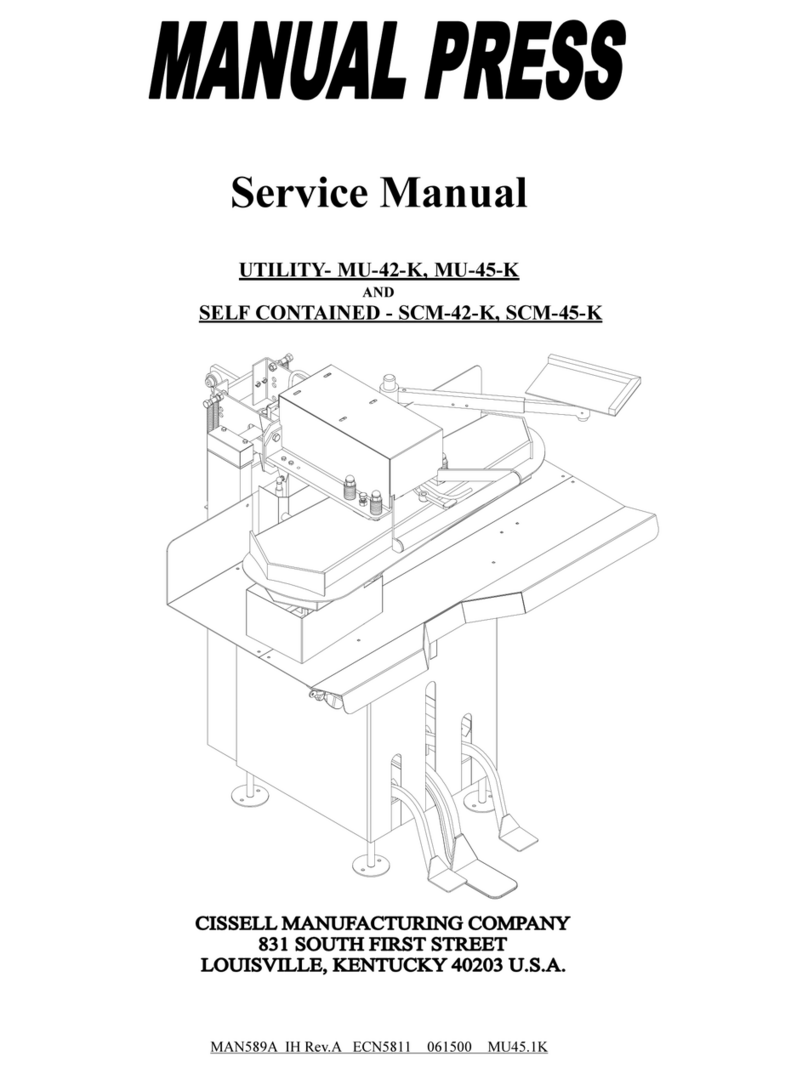Sovereign AJ65A User guide


2
CONTENTS
CONTENTS 2
GENERAL SAFETY WARNINGS 3
WARNING SYMBOLS 9
IN THE BOX 10
OPERATION 11
MAINTENANCE AND STORAGE 18
TECHNICAL DATA 19
RECYCLING AND DISPOSAL 21
UK PLUG 21
GETTING HELP 22
WARRANTY 23

3
GENERAL SAFETY WARNINGS
WARNING! Read all safety warnings,
instructions, illustrations and specifications
provided with this power tool. Failure to
follow all instructions listed below may result
in electric shock, fire and/or serious injury.
Save all warnings and instructions for
future reference. The term ‘power tool’ in
the warnings refers to your mains-operated
(corded) power tool or battery-operated
(cordless) power tool.
1) Work area safety
a) Keep work area clean and well lit. Cluttered or
dark areas invite accidents.
b) Do not operate power tools in explosive
atmospheres, such as in the presence of
flammable liquids, gases or dust. Power tools
create sparks which may ignite the dust or fumes.
c) Keep children and bystanders away while
operating a power tool. Distractions can cause
you to lose control.
2) Electrical safety
a) Power tool plugs must match the outlet. Never
modify the plug in any way. Do not use any
adaptor plugs with earthed (grounded) power
tools. Unmodified plugs and matching outlets will
reduce risk of electric shock.
b) Avoid body contact with earthed or grounded

4
surfaces, such as pipes, radiators, ranges and
refrigerators. There is an increased risk of electric
shock if your body is earthed or grounded.
c) Do not expose power tools to rain or wet
conditions. Water entering a power tool will
increase the risk of electric shock.
d) Do not abuse the cord. Never use the cord for
carrying, pulling or unplugging the power tool.
Keep the cord away from heat, oil, sharp edges
or moving parts. Damaged or entangled cords
increase the risk of electric shock.
e) When operating a power tool outdoors, use an
extension cord suitable for outdoor use. Use of
a cord suitable for outdoor use reduces the risk of
electric shock.
f) If operating a power tool in a damp location
is unavoidable, use a residual current device
(RCD) protected supply. Use of an RCD reduces
the risk of electric shock.
3) Personal safety
a) Stay alert, watch what you are doing and
use common sense when operating a power
tool. Do not use a power tool while you are
tired or under the influence of drugs, alcohol
or medication. A moment of inattention while
operating power tools may result in serious
personal injury.
b) Use personal protective equipment (PPE).
Always wear eye protection. Protective

5
equipment such as a dust mask, non-skid safety
shoes, hard hat, or hearing protection used for
appropriate conditions will reduce personal
injuries.
c) Prevent unintentional starting. Ensure the
switch is in the 'off' position before connecting
to a power source and/or battery pack, picking
up or carrying the tool. Carrying power tools
with your finger on the switch or energising power
tools that have the switch on invites accidents.
d) Remove any adjusting key or wrench before
turning the power tool on. A wrench or a key left
attached to a rotating part of the power tool may
result in personal injury.
e) Do not overreach. Keep proper footing and
balance at all times. This enables better control
of the power tool in unexpected situations.
f) Dress properly. Do not wear loose clothing or
jewellery. Keep your hair, clothing and gloves
away from moving parts. Loose clothes, jewellery
or long hair can be caught in moving parts.
g) If devices are provided for the connection of
dust extraction and collection facilities, ensure
these are connected and properly used. Use of
these devices can reduce dust-related hazards.
h) Do not let familiarity gained from frequent use
of tools allow you to become complacent and
ignore tool safety principles. A careless action
can cause severe injury within a fraction of a
second.

6
4) Power tool use and care
a) Do not force the power tool. Use the correct
power tool for your application. The correct
power tool will do the job better and safer at the
rate for which it was designed.
b) Do not use the power tool if the switch does
not turn it on and off. Any power tool that cannot
be controlled with the switch is dangerous and
must be repaired.
c) Disconnect the plug from the power source
and/or the battery pack from the power tool
before making any adjustments, changing
accessories, or storing power tools. Such
preventive safety measures reduce the risk of
starting the power tool accidentally.
d) Store idle power tools out of the reach of
children, and do not allow persons unfamiliar
with the power tool or these instructions
to operate the power tool. Power tools are
dangerous in the hands of untrained users.
e) Maintain power tools. Check for misalignment
or binding of moving parts, breakage of parts
and any other condition that may affect the
power tools operation. If damaged, have the
power tool repaired before use. Many accidents
are caused by poorly maintained power tools.
f) Keep cutting tools sharp and clean. Properly
maintained cutting tools with sharp cutting edges
are less likely to bind and are easier to control.
g) Use the power tool, accessories and tool bits,

7
etc., in accordance with these instructions,
taking into account the working conditions and
the work to be performed. Use of the power tool
for operations different from those intended could
result in a hazardous situation.
h) Keep handles and gripping surfaces dry, clean
and free from oil and grease. Slippery handles
and gripping surfaces do not allow for safe
handling and control of the tool in unexpected
situations.
Service
a) Have your power tool serviced by a qualified
repair person using only identical replacement
parts. This will ensure that the safety of the power
tool is maintained.
ADDITIONAL SAFETY WARNINGS FOR SANDERS
a. Harmful/toxic dusts will arise from sanding,
e.g. lead painted surfaces, woods and metals.
Contact with or inhalation of these dusts
can endanger the health of the operator and
bystanders. Always use eye goggles and a dust
mask.
b. Hearing protection should be worn when using
the sander.
c. Always wear safety glasses or eye shields
when using the sander. Everyday spectacles
have only impact-resistant lenses; they are not

8
safety glasses. Following this rule will reduce the
risk of serious personal injury.
d. After long working periods, external metal
parts and accessories could be hot.
e. If possible, ensure the work-piece is firmly
clamped to prevent movement.
f. Your sander is a hand held tool; do not clamp
your sander.
g. Before sanding, check the area is free of nails,
screws, etc.
h. Never stop the sander by applying a force to
the base plate.
i. Only use sand paper in good condition. Do not
use torn or worn paper.
j. Do not sand material containing asbestos, due
to a health risk.
k. Do not sand lead-based paint due to the risk of
lead poisoning.
l. Do not eat or drink in the working area of the
sander.
m. Do not allow people to enter the working area
without wearing a dust mask.
n. Where possible, seal off the working area to
contain the dust for later removal.
o. Your tool is designed for dry sanding only, not
wet sanding.
p. Do not sand magnesium material due to the
risk of fire.

9
WARNING SYMBOLS
Warning
Read the instructions
Wear ear protection
Wear eye protection
Wear a dust mask
Class II tool
The product complies with the applicable
European directives, and an evaluation method
of conformity for these directives was done.
Recycle unwanted materials instead of
disposing of them as household waste. All tools,
hoses and packaging should be sorted, taken to
the local recycling centre and disposed of in an
environmentally safe way.
The product complies with the applicable UK
directives, and an evaluation method of conformity
for these directives was followed.

10
IN THE BOX
Description
1. Speed selection
2. On/off switch
3. Dust outlet
4. Fasten clip
5. Sanding base
6. Dust collection box
7. Soft grip
Accessories
1pc 80# sanding paper

11
OPERATION
NOTE: Before using your sander, be sure to read the
instruction manual carefully.
INTENDED USE
This tool is intended for dry sanding of wood, plastic, filler and
coated surfaces.
1. FITTING THE SANDING PAPER
SANDING PAPER WITH CLIP SYSTEM (SEE FIG. A, B, C, D)
FIT THE SANDING PAPER
Fit the sanding paper over the base. Make sure the sanding
paper is even with the edges, and that the dust collection
holes in the base and sanding paper is aligned, and that the
sanding paper is taut on the base.
Lift the sanding paper retaining clips to the open position and
insert one end of the sanding paper under the retaining clip.
Push the clip back into the retaining position. Lightly stretch
the paper over the base plate ensuring that it is not folded
or wrinkled, then position under the other retaining clip back
into the retaining position. Check that the paper is flat to the
base plate, if not, release either clip and reposition the paper
before resetting the clip. Switch on momentarily to check that
the sander is functioning correctly. If there is undue vibration,
repeat the paper positioning procedure.
REMOVE THE SANDING PAPER
To remove the sanding paper, liftup the clamp lever and move
away from the clamp lever lock. The sanding paper clamp is
now loose. Repeat with the other clamp on the opposite side
of your sander.

12

13

14
B C2. USING THE DUST COLLECTION BOX (SEE FIG. E)
A) ATTACH THE DUST BOX
Your sander is equipped with a dust collection box (6), which
is designed for collect dust. Insert the dust collection box into
the rear dust outlet the sander. Then pull the dust collection
box and make sure it is tightened securely on the dust outlet.
CAUTION: To prevent the possibility of sanding dust
or foreign objects being thrown into your face or
eyes, never attempt to use your sander without the
collection box properly installed.
B) EMPTY DUST BOX
For more efficient operation, empty the dust box every
5-10mins. This will permit the air to flow through the box
efficiently.
To empty the dust box, pull off the from out of the dust
extraction outlet directly and shake out the dust.
3. USING THE DUST OUTLET (SEE FIG. F)
Your sander is equipped with a 35mm dust outlet, which is
designed for connecting the hose of a vacuum cleaner.
If the vacuum hose is 35mm, insert the hose directly into the
rear dust outlet of the sander.

15
First, turn on the vacuum cleaner, and then turn on the
sander. If you stop sanding, first turn off the sander and then
turn off your vacuum cleaner.
NOTE: Please pull the dust adaptor to make sure it is
tightened securely to the dust outlet.
4. OPERATING THE ON/OFF SWITCH (SEE FIG. G)
Slide the on/off switch to the position marked 'I' to start the
tool. Slide it to the position marked '0' to stop it.

16
5. USING THE SANDER
The workpiece to be sanded must be secured. If it is small or it
may move during sanding, it must be held in a vice or suitably
clamped.
Be sure to hold the sander firmly whilst it is on and apply
it gently to the work, it may 'kick' on first contact. Hold
the sander so that it is flat on the work and move slowly,
preferably with a smooth, circular motion. Regularly check the
condition of the sanding paper and replace when worn for
best results.
6. FLUSH SANDING FACILITY
Your sander can sand flush on three sides of the baseplate,
which allows easy access to corners and edges of moldings.
7. ORBITAL SANDING
Your sander operates in small a circular rotation which
allows efficient material removal. Operate your sander in
long sweeping movements across your workpiece and even
across the grain. For a finer finish, always use a fine grain
sanding paper, and only move the sander in the direction of
the grit and never across the grain. Do not allow your sander
to remain in the same position otherwise you will remove
material and create an uneven surface.
8. SELECT THE RIGHT SAND PAPER
Selecting the correct grit of sandpaper is an extremely
important decision that will allow you to achieve the best
quality sanding finish.
Coarse grit will remove the most material and finer grit
will give you the best finish in all sanding operations. The
condition of the surface to be sanded will determine which grit
will do the job.

17
If the surface is rough:
Start with coarse grit (sold separately) and sand until the
surface is uniform. Then use medium to remove any scratches
left by the coarse grit. Then use finer grit (sold separately) for
finishing the surface.
NOTE:Always continue sanding with each grit until the surface
is uniform.

18
MAINTENANCE AND STORAGE
IMPORTANT!
Make sure that the tool has been thoroughly cleaned
before storing it in a clean, dry and safe place, out of
the reach of children.
1. Switch the product 'OFF' and disconnect it from the power
supply before transporting it anywhere.
2. Always carry the product on its gripping surfaces.
3. Protect the product from any heavy impact or strong
vibrations which may occur during transportation in
vehicles.
4. Secure the product to prevent it from slipping or falling
over.
If the supply cord is damaged, it must be replaced by the
manufacturer, its service agent or similarly qualified persons
in order to avoid a hazard.

19
TECHNICAL DATA
Model AJ65A
Voltage/power 230-240V~ 50Hz/200W
No-load speed 6000-12000/min
Sanding pad size 90x187mm
Protection class / II
Weight 1.9kg
NOISE AND VIBRATION DATA
A weighted sound pressure (LpA) 80.6 dB(A), k=3dB(A)
A weighted sound power (LwA) 91.6 dB(A), k=3dB(A)
Vibrations ah=8.106 m/s2 , K=1,5 m/s2
The sound intensity level for the operator may exceed 80
dB(A) and ear protection measures are necessary.
The declared vibration value has been measured in
accordance with a standard test method (according to EN
62841) and may be used for comparing one product with
another. The declared vibration value may also be used in a
preliminary assessment of exposure.
WARNING!
The vibration emission value during actual use of
the power tool can differ from the declared value
depending on the ways in which the tool is used and
dependant on the following examples and other
variations on how the tool is used:
How the tool is used and the materials being cut or
drilled.
The tool being in good condition and well maintained.
Using the correct accessory for the tool and ensuring it
is sharp and in good condition.
The tightness of the grip on the handles and if any
anti-vibration accessories are used.
And the tool is being used as intended by its design
and these instructions.

20
This tool may cause hand-arm vibration syndrome if its
use is not adequately managed.
WARNING! To be accurate, an estimation of exposure
level in the actual conditions of use should also take
account of all parts of the operating cycle, such as
the times when the tool is switched off and when it is
running idle but not actually doing the job. This may
significantly reduce the exposure level over the total
working period.
Helping to minimise your vibration exposure risk.
ALWAYS use sharp chisels, drills and blades.
Maintain this tool in accordance with these instructions
and keep well lubricated (where appropriate).
If the tool is to be used regularly then invest in anti-
vibration accessories.
Plan your work schedule to spread any high vibration
tool use across a number of days.
This manual suits for next models
1
Table of contents
Popular Sander manuals by other brands
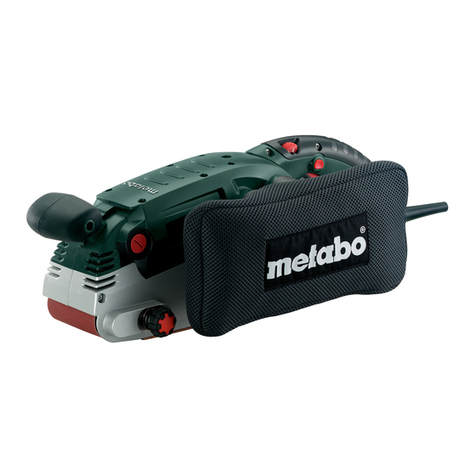
Metabo
Metabo BAE 75 Original instructions

Bosch
Bosch Professional GWX 180-LI Original instructions
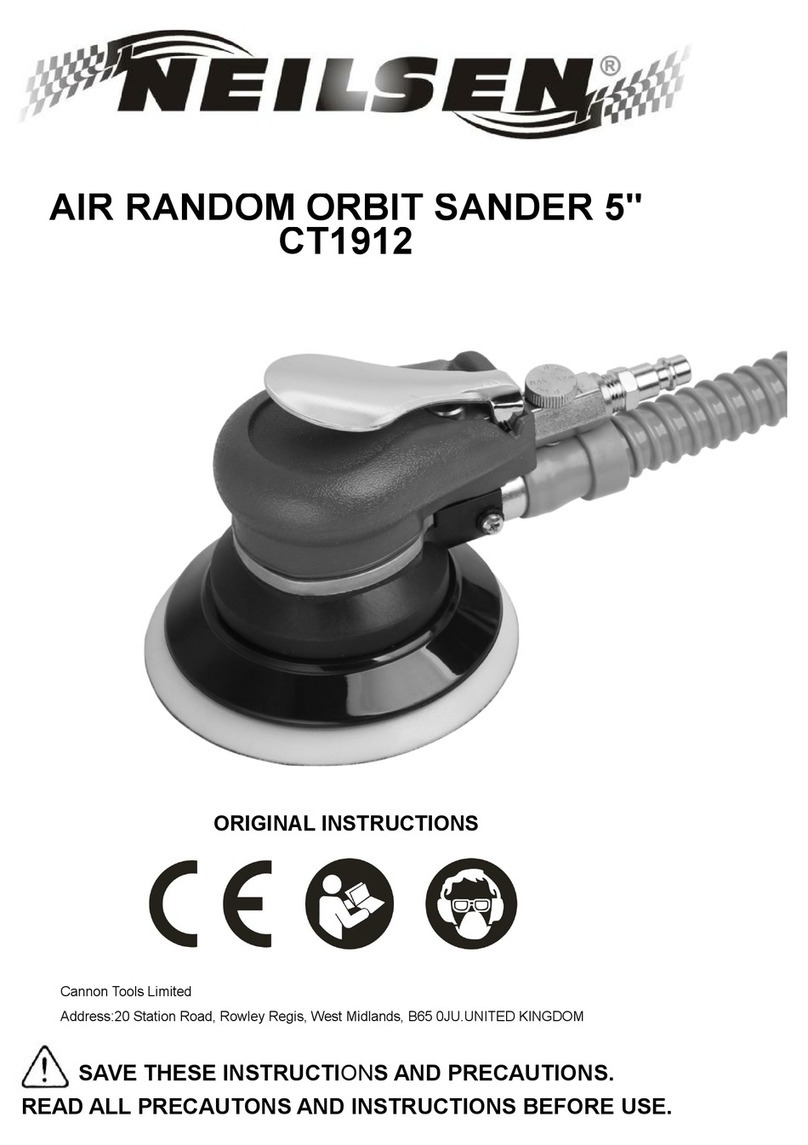
Neilsen
Neilsen CT1912 Original instructions
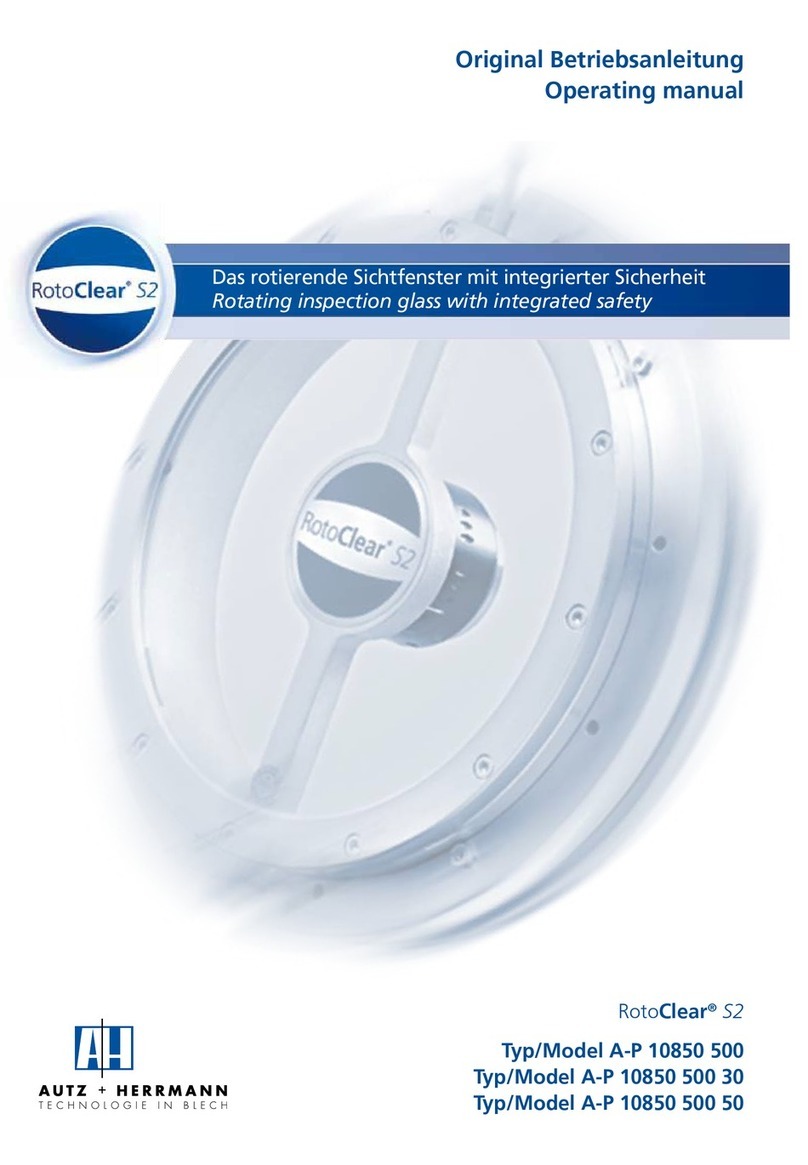
Autz + Herrmann
Autz + Herrmann RotoClear S2 A-P 10850 500 operating manual
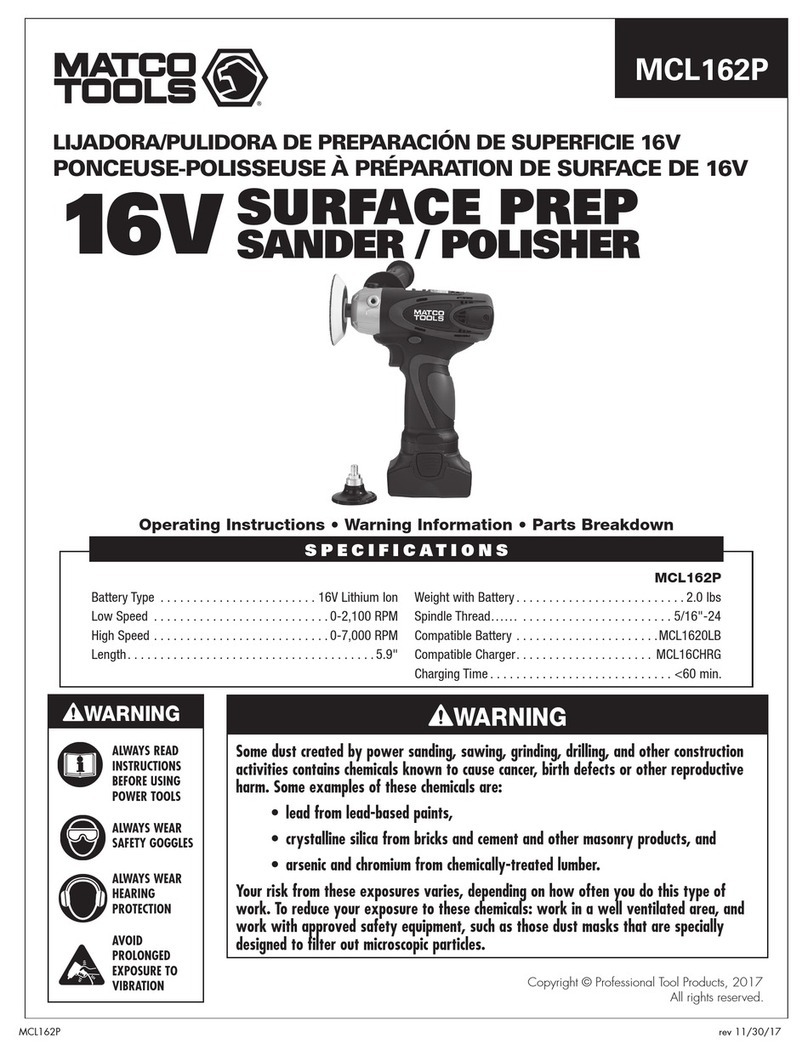
Matco Tools
Matco Tools MCL162P operating instructions

Parkside
Parkside PHS 160 B3 Operation manual
